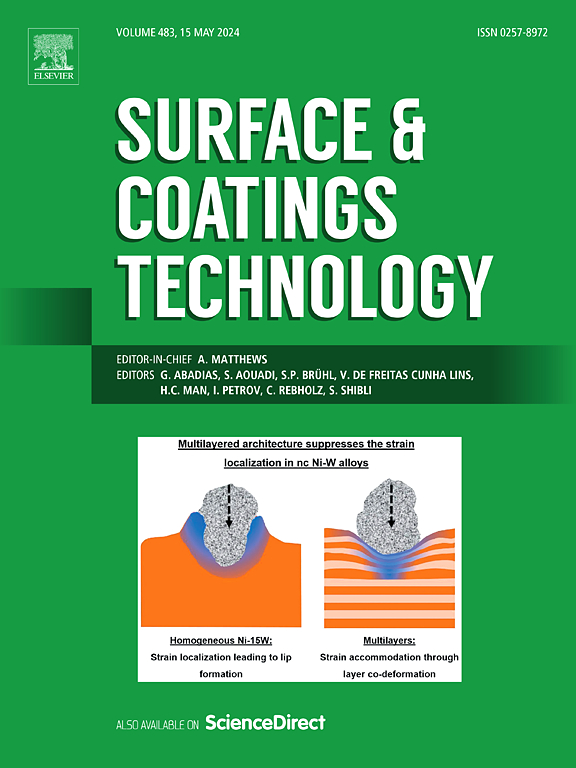用MgGd合金化三元TiAlN涂层增强腐蚀性能
IF 5.3
2区 材料科学
Q1 MATERIALS SCIENCE, COATINGS & FILMS
引用次数: 0
摘要
本研究通过将 TiAlN 与 MgGd 进行合金化,对新型 PVD 涂层的耐腐蚀性能进行了研究。在以前的研究中,对 TiN 进行 MgGd 合金处理可在中性盐雾(NSS)测试中获得长达 1000 小时的出色耐腐蚀性,并改善了在碱性环境中的性能。腐蚀保护归因于疏水表面效应、化学惰性钝化层和缺陷容忍度的综合作用。在这些研究成果的基础上,本研究将合金化概念扩展到基于 TiAlN 的三元体系。研究人员合成了不同铝/镁比例的 TiAlMgGdN 涂层,并将其与 TiMgGdN 参考材料进行比较,以评估铝对微观结构、机械性能和腐蚀行为的影响。表征采用 SEM、XRD 和 XPS 进行。化学成分是通过 GDOES 和 EDX 确定的。在中性、碱性和酸性条件下,通过 NSS 和电位测试评估了腐蚀特性。铝含量的增加导致平均晶粒尺寸从 15.2 nm 减小到 4.8 nm,涂层硬度从 13.5 GPa 增加到 18.5 GPa。与 TiMgGdN 相比,TiAlMgGdN 的腐蚀电位在酸性介质中偏移了 +129.7 mV,在碱性介质中偏移了 +68.9 mV。尽管含铝涂层的缺陷密度更高(284 个缺陷/毫米对 171 个缺陷/毫米),且具有更高的惰性,但其耐腐蚀性能却更胜一筹。这要归功于形成了化学性质稳定的保护性 Al2O3 钝化层,它可以补偿结构缺陷并限制腐蚀性物质的侵入。这项工作的新颖之处在于首次将 MgGd 合金概念应用于 TiAlN 基体,证明了铝和稀土元素的协同作用可显著增强腐蚀防护和机械性能,尤其是在侵蚀性环境中。本文章由计算机程序翻译,如有差异,请以英文原文为准。
Enhancement of the corrosion properties by alloying ternary TiAlN coatings with MgGd
This study investigates the corrosion resistance of novel PVD coatings by alloying TiAlN with MgGd. In previous work, MgGd alloying of TiN resulted in outstanding corrosion resistance of up to 1000 h in neutral salt spray (NSS) testing and improved performance in alkaline environments. The corrosion protection was attributed to a combination of hydrophobic surface effects, chemically inert passivation layers, and defect tolerance. To build on these findings, this study extends the alloying concept to ternary TiAlN-based systems. TiAlMgGdN coatings with varying Al/Mg ratios were synthesized and compared with a TiMgGdN reference to evaluate the influence of Al on microstructure, mechanical properties, and corrosion behavior. Characterization was performed using SEM, XRD, and XPS. The chemical composition was determined via GDOES and EDX. Corrosion properties were assessed under neutral, alkaline, and acidic conditions with NSS and potentiodynamic testing. Increasing the Al content led to a reduction in average crystallite size from 15.2 nm to 4.8 nm and an increase in coating hardness from 13.5 GPa to 18.5 GPa. Corrosion potential shifted by +129.7 mV in acidic and +68.9 mV in alkaline media for TiAlMgGdN relative to TiMgGdN. Despite a higher defect density (284 defects/mm vs. 171 defects/mm) and the more noble character, the Al-containing coatings demonstrated superior corrosion resistance. This is attributed to the formation of a chemically stable and protective Al2O3 passivation layer that compensates for structural imperfections and limits the ingress of corrosive species. The novelty of this work lies in the first application of the MgGd alloying concept to a TiAlN matrix, demonstrating that the synergistic effects of Al and rare-earth elements significantly enhance both corrosion protection and mechanical performance, particularly in aggressive environments.
求助全文
通过发布文献求助,成功后即可免费获取论文全文。
去求助
来源期刊

Surface & Coatings Technology
工程技术-材料科学:膜
CiteScore
10.00
自引率
11.10%
发文量
921
审稿时长
19 days
期刊介绍:
Surface and Coatings Technology is an international archival journal publishing scientific papers on significant developments in surface and interface engineering to modify and improve the surface properties of materials for protection in demanding contact conditions or aggressive environments, or for enhanced functional performance. Contributions range from original scientific articles concerned with fundamental and applied aspects of research or direct applications of metallic, inorganic, organic and composite coatings, to invited reviews of current technology in specific areas. Papers submitted to this journal are expected to be in line with the following aspects in processes, and properties/performance:
A. Processes: Physical and chemical vapour deposition techniques, thermal and plasma spraying, surface modification by directed energy techniques such as ion, electron and laser beams, thermo-chemical treatment, wet chemical and electrochemical processes such as plating, sol-gel coating, anodization, plasma electrolytic oxidation, etc., but excluding painting.
B. Properties/performance: friction performance, wear resistance (e.g., abrasion, erosion, fretting, etc), corrosion and oxidation resistance, thermal protection, diffusion resistance, hydrophilicity/hydrophobicity, and properties relevant to smart materials behaviour and enhanced multifunctional performance for environmental, energy and medical applications, but excluding device aspects.
 求助内容:
求助内容: 应助结果提醒方式:
应助结果提醒方式:


